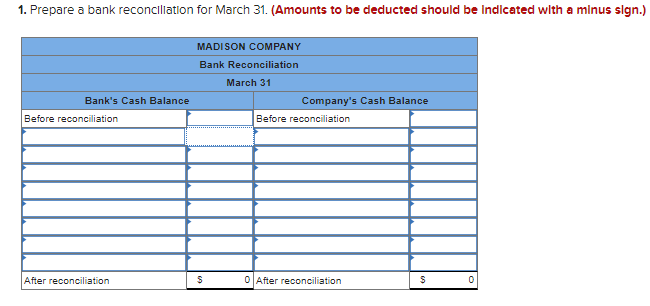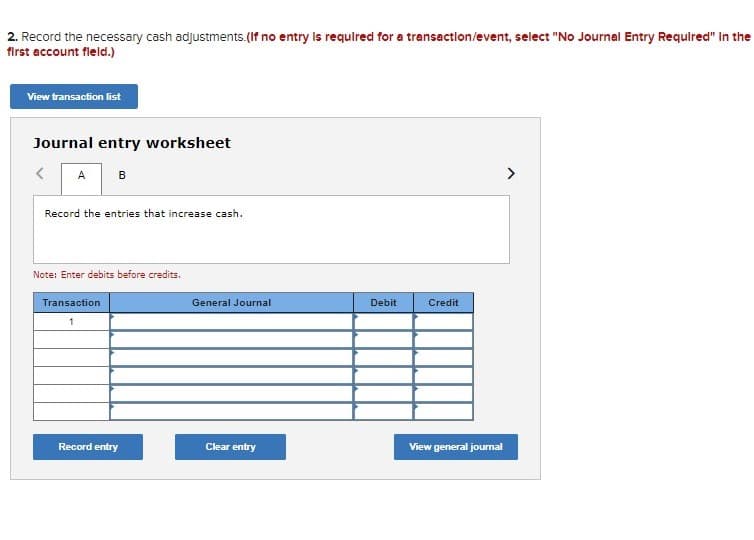Madison Company's cash ledger reports the following for the month ending March 31. Date Amount No. Date Amount Deposits: 3/4 $ 1,400 Checks: 541 3/2 $ 5,700 3/11 1,700 542 3/8 700 3/18 3,700 543 3/12 3,000 3/25 3,500 544 3/19 1,500 Cash receipts: 3/26-3/31 2,100 545 3/27 700 $ 12,400 546 3/28 800 547 3/30 1,200 Balance on March 1 $ 6,100 $ 13,600 Receipts 12,400 Disbursements (13,600 ) Balance on March 31 $ 4,900 Information from March's bank statement and company records reveal the following additional information: The ending cash balance recorded in the bank statement is $6,970. Cash receipts of $2,100 from 3/26–3/31 are outstanding. Checks 545 and 547 are outstanding. The deposit on 3/11 included a customer's check for $410 that did not clear the bank (NSF check). Check 543 was written for $3,600 for office supplies in March. The bank properly recorded the check for this amount. An automatic withdrawal for March rent was made on March 4 for $1,100. Madison's checking account earns interest based on the average daily balance. The amount of interest earned for March is $54. Last year, one of Madison's top executives borrowed $4,100 from Madison. On March 24, the executive paid $4,400 ($4,100 borrowed amount plus $300 interest) directly to the bank in payment for the borrowing. The bank charged the following service fees: $34 for NSF check, $15 for automatic withdrawal for rent payment, and $25 for collection of the loan amount from the executive. 1. Prepare a bank reconciliation for March 31. (Amounts to be deducted should be indicated with a minus sign.) *picture attached 2. Record the necessary cash adjustments for A & B. (If no entry is required for a transaction/event, select "No Journal Entry Required" in the first account field.) * A) Record the entries that increase cash & B) Record the entries that decrease cash. *picture attached to use as a guide for A&
Madison Company's cash ledger reports the following for the month ending March 31. Date Amount No. Date Amount Deposits: 3/4 $ 1,400 Checks: 541 3/2 $ 5,700 3/11 1,700 542 3/8 700 3/18 3,700 543 3/12 3,000 3/25 3,500 544 3/19 1,500 Cash receipts: 3/26-3/31 2,100 545 3/27 700 $ 12,400 546 3/28 800 547 3/30 1,200 Balance on March 1 $ 6,100 $ 13,600 Receipts 12,400 Disbursements (13,600 ) Balance on March 31 $ 4,900 Information from March's bank statement and company records reveal the following additional information: The ending cash balance recorded in the bank statement is $6,970. Cash receipts of $2,100 from 3/26–3/31 are outstanding. Checks 545 and 547 are outstanding. The deposit on 3/11 included a customer's check for $410 that did not clear the bank (NSF check). Check 543 was written for $3,600 for office supplies in March. The bank properly recorded the check for this amount. An automatic withdrawal for March rent was made on March 4 for $1,100. Madison's checking account earns interest based on the average daily balance. The amount of interest earned for March is $54. Last year, one of Madison's top executives borrowed $4,100 from Madison. On March 24, the executive paid $4,400 ($4,100 borrowed amount plus $300 interest) directly to the bank in payment for the borrowing. The bank charged the following service fees: $34 for NSF check, $15 for automatic withdrawal for rent payment, and $25 for collection of the loan amount from the executive. 1. Prepare a bank reconciliation for March 31. (Amounts to be deducted should be indicated with a minus sign.) *picture attached 2. Record the necessary cash adjustments for A & B. (If no entry is required for a transaction/event, select "No Journal Entry Required" in the first account field.) * A) Record the entries that increase cash & B) Record the entries that decrease cash. *picture attached to use as a guide for A&
Financial And Managerial Accounting
15th Edition
ISBN:9781337902663
Author:WARREN, Carl S.
Publisher:WARREN, Carl S.
Chapter7: Internal Control And Cash
Section: Chapter Questions
Problem 22E
Related questions
Question
Madison Company's cash ledger reports the following for the month ending March 31.
| Date | Amount | No. | Date | Amount | |||||||
| Deposits: | 3/4 | $ | 1,400 | Checks: | 541 | 3/2 | $ | 5,700 | |||
| 3/11 | 1,700 | 542 | 3/8 | 700 | |||||||
| 3/18 | 3,700 | 543 | 3/12 | 3,000 | |||||||
| 3/25 | 3,500 | 544 | 3/19 | 1,500 | |||||||
| Cash receipts: | 3/26-3/31 | 2,100 | 545 | 3/27 | 700 | ||||||
| $ | 12,400 | 546 | 3/28 | 800 | |||||||
| 547 | 3/30 | 1,200 | |||||||||
| Balance on March 1 | $ | 6,100 | $ | 13,600 | |||||||
| Receipts | 12,400 | ||||||||||
| Disbursements | (13,600 | ) | |||||||||
| Balance on March 31 | $ | 4,900 | |||||||||
Information from March's bank statement and company records reveal the following additional information:
- The ending cash balance recorded in the bank statement is $6,970.
- Cash receipts of $2,100 from 3/26–3/31 are outstanding.
- Checks 545 and 547 are outstanding.
- The deposit on 3/11 included a customer's check for $410 that did not clear the bank (NSF check).
- Check 543 was written for $3,600 for office supplies in March. The bank properly recorded the check for this amount.
- An automatic withdrawal for March rent was made on March 4 for $1,100.
- Madison's checking account earns interest based on the average daily balance. The amount of interest earned for March is $54.
- Last year, one of Madison's top executives borrowed $4,100 from Madison. On March 24, the executive paid $4,400 ($4,100 borrowed amount plus $300 interest) directly to the bank in payment for the borrowing.
- The bank charged the following service fees: $34 for NSF check, $15 for automatic withdrawal for rent payment, and $25 for collection of the loan amount from the executive.
1. Prepare a bank reconciliation for March 31. (Amounts to be deducted should be indicated with a minus sign.) *picture attached
2. Record the necessary cash adjustments for A & B. (If no entry is required for a transaction/event, select "No

Transcribed Image Text:1. Prepare a bank reconciliation for March 31. (Amounts to be deducted should be Indicated with a minus sign.)
MADISON COMPANY
Bank Reconciliation
March 31
Bank's Cash Balance
Company's Cash Balance
Before reconciliation
Before reconciliation
After reconciliation
O After reconciliation

Transcribed Image Text:2. Record the necessary cash adjustments.(If no entry Is required for a transactlon/event, select "No Journal Entry Required" In the
first account fleld.)
View transaction list
Journal entry worksheet
A
>
Record the entries that increase cash.
Note: Enter debits before credits.
Transaction
General Journal
Debit
Credit
1
Record entry
Clear entry
View general jourmal
B.
Expert Solution
This question has been solved!
Explore an expertly crafted, step-by-step solution for a thorough understanding of key concepts.
This is a popular solution!
Trending now
This is a popular solution!
Step by step
Solved in 2 steps

Knowledge Booster
Learn more about
Need a deep-dive on the concept behind this application? Look no further. Learn more about this topic, accounting and related others by exploring similar questions and additional content below.Recommended textbooks for you

Financial And Managerial Accounting
Accounting
ISBN:
9781337902663
Author:
WARREN, Carl S.
Publisher:
Cengage Learning,

Corporate Financial Accounting
Accounting
ISBN:
9781305653535
Author:
Carl Warren, James M. Reeve, Jonathan Duchac
Publisher:
Cengage Learning

Survey of Accounting (Accounting I)
Accounting
ISBN:
9781305961883
Author:
Carl Warren
Publisher:
Cengage Learning

Financial And Managerial Accounting
Accounting
ISBN:
9781337902663
Author:
WARREN, Carl S.
Publisher:
Cengage Learning,

Corporate Financial Accounting
Accounting
ISBN:
9781305653535
Author:
Carl Warren, James M. Reeve, Jonathan Duchac
Publisher:
Cengage Learning

Survey of Accounting (Accounting I)
Accounting
ISBN:
9781305961883
Author:
Carl Warren
Publisher:
Cengage Learning

Principles of Accounting Volume 1
Accounting
ISBN:
9781947172685
Author:
OpenStax
Publisher:
OpenStax College

College Accounting, Chapters 1-27
Accounting
ISBN:
9781337794756
Author:
HEINTZ, James A.
Publisher:
Cengage Learning,

College Accounting (Book Only): A Career Approach
Accounting
ISBN:
9781337280570
Author:
Scott, Cathy J.
Publisher:
South-Western College Pub